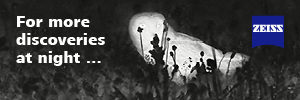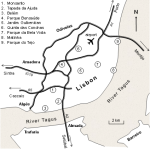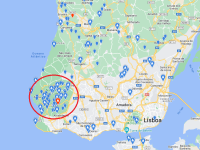Thanks for the answers.
There are two ways of doing this: either hiring a guide or doing it on your own
I usually prefer to do birding on my own, even though this means seeing fewer species, I like exploring ths ites at my own pace. But of course it's up to you.
In Lisbon city you can get anywhere using public transportation. I would suggest the following nine places (see attached map)
View attachment 1507135
Site 1 (Monsanto) is the largest Park in town, it is in fact a forest. You can find a good variety of land birds including Red-legged Partridge, Buzzard, Turtle Dove, Great Spotted Woodpecker, Grey Wagtail, Sardinian Warbler, Firecrest, Long-tailed Tit, Coal Tit, Short-toed Treecreeper, Jay, Spotless Starling, Serin and sometimes Night Heron. Not easy to explore on foot but a few hotspots can be reached using a bus.
Site 2 (Tapada da Ajuda) lies just south of 1 and is the same type of habitat with some open fields. It is easier to get to than site 1, it is surrounded by a wall and has not much traffic so it's a good place to walk around (entry free for pedestrians). You can expect Red-legged Partridge, Buzzard, Turtle Dove, Ring-necked Parakeet (introduced), Great Spotted Woodpecker, Black Redstart, Zitting Cisticola, Sardinian Warbler, Firecrest, Coal Tit, Short-toed Treecreeper, Jay, Serin, Common Waxbill.
Site 3 (Belém) is an area of gardens close to the most famous monuments (Jerónimos and Belém Tower), on the bank of the Tagus river. Typical birds at this time of year include Yellow-legged Gull, Black Redstart, Sardinian Warbler, Firecrest, Short-toed Treecreeper, Crested Myna (introduced) and Spotless Starling
Site 4 (Parque Bensaúde) is a small but interesting park not far from Benfica (underground station Alto dos Moinhos). It is a quiet area for a short walk. Resident birds include Wood Pigeon, Ring-necked Parakeet (introduced), Blue-headed Parakeet (introduced), Senegal Parrot (introduced, scarce), Great Spotted Woodpecker, Black Redstart, Sardinian Warbler, Firecrest, Coal Tit, Short-toed Treecreeper, Jay, Spotless Starling and Serin. Breeding visitors include Turtle Dove, House Martin and Red-rumped Swallow.
Site 5 (Gulbenian gardens) is another interesting park, close to Praça de Espanha (easily reached by underground). It has large trees and a lake. You can see Egyptian Goose (introduced and probably feral), Mallard (feral), Moorhen, Wood Pigeon, Ring-necked Parakeet (introduced), White Wagtail, Wren, Blackbird, Blackcap, Coal Tit, Blue Tit, Short-toed Treecreeper, Spotless Starling, House Sparrow, Serin and Greenfinch. If you look at the sky you will probably see Common and Pallid Swifts.
Site 6 is yet another a park that is also easy to get to by underground (Quinta das Conchas station). Birds here include Egyptian Goose (feral), Wood Pigeon, Ring-necked Parakeet (introduced), Blue-headed Parakeet (introduced), White Wagtail, Blackcap, Sardinian Warbler, Firecrest, Coal Tit, Short-toed Treecreeper, Jay, Spotless Starling and Serin.
Site 7 is an open park with lawn, probably not so interesting at this time of year but there are good chances of Crested Lark and Hoopoe.
Site 8 is part of the Lisbon harbour. More interesting in autumn and winter but worth checking at any time of year as there may be some gulls, waders or herons. Definitely best at low tide.
Site 9 is a very interesting park on the shore of the river Tagus. Like site 8, it is best outide the breeding season, but even in May you can find interesting species. Typical birds include Mallard, Little Egret, Kestrel, Peregrine, Crested Lark, Cetti’s Warbler, Zitting Cisticola, Spotless Starling, Serin and Common Waxbill.
Outside town you can go westwards towards Oeiras and Cascais using local trains and reach a few more birding locations.
All these sites can be visited on your own. I hope this helps, I can provide additional details if you wish.








